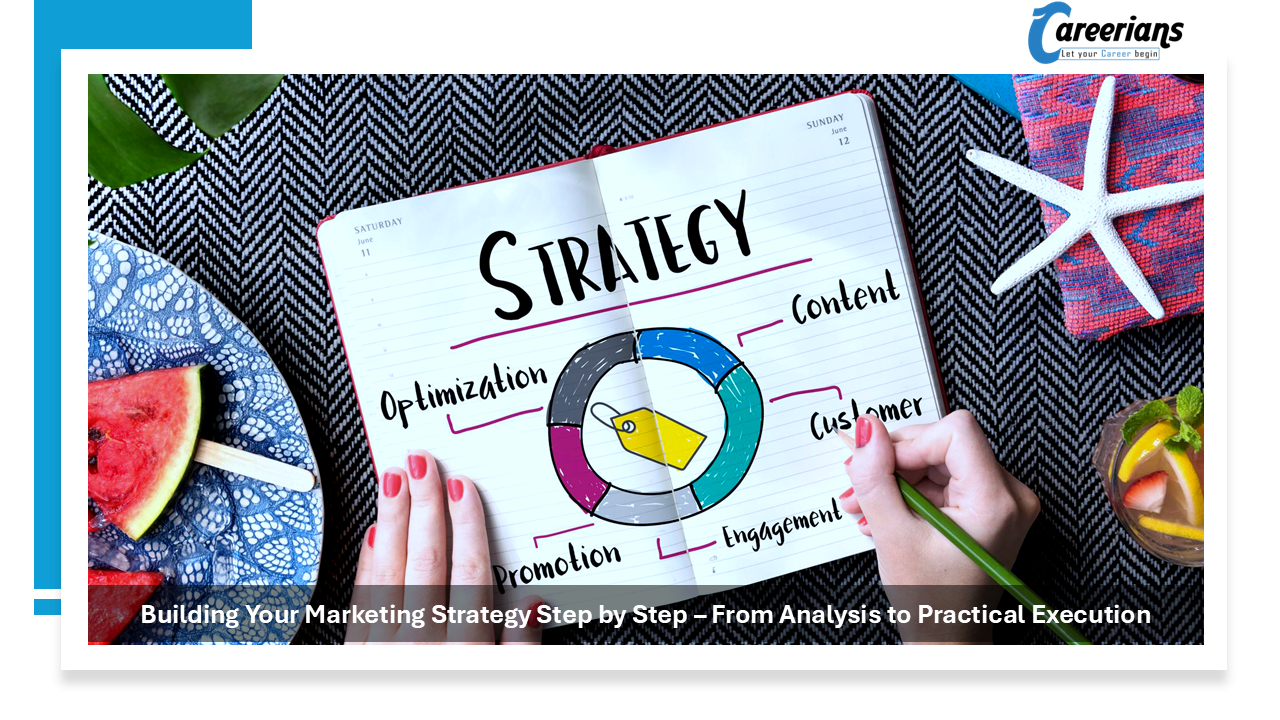
Building Your Marketing Strategy Step by Step – From Analysis to Practical Execution
Building Your Marketing Strategy Step by Step – From Analysis to Practical Execution
(A realistic hands-on Marketing Strategy guide for SMEs in Egypt and the Gulf)
In today’s fast-changing market, competition isn’t just about who offers the lowest price or the best product — it’s about who has the smarter strategy.
A marketing strategy isn’t an ad on Facebook or a seasonal discount. It’s a complete system that starts with understanding your market and ends with a measurable Marketing Strategy and action plan.
Small and medium-sized companies in Egypt and the Gulf face a common question:
How can we build an effective marketing strategy without a huge budget — and still compete with the big players?
This Marketing Strategy Step by Step guide takes you through every step — from analysis to execution — with examples from real regional companies, written in the practical Careerians style.
Step 1: Understand Your Market Before You Move
Most small businesses start marketing without understanding the market they’re playing in. They assume demand exists, but when asked “Who exactly are your customers?” — the answer is often unclear to build the most suitable Marketing Strategy Step by Step.
1. Market Analysis
Start by gathering simple but solid data:
-
Market size and trends
-
Main competitors
-
Customer profiles and pricing patterns
Ask yourself:
-
Is this market growing or shrinking?
-
Who are the key players?
-
What new opportunities are being ignored?
Example:
A small beverage distributor in Cairo noticed a rising trend in healthy drinks at gyms and cafés. They shifted focus from small shops to gym partnerships, increasing sales by 40% within six months.
2. Competitor Analysis
Create a table listing:
-
Competitor names
-
Product offerings and prices
-
Strengths and weaknesses
-
Channels they use (social media, offline, etc.)
You’re not doing this to copy them — but to identify how you can differentiate.
Example:
A cleaning services company in Dubai realized all competitors were focused on being the cheapest. They instead positioned themselves as fast and premium, introducing monthly subscription packages. Within months, recurring customers grew by 60%.
Step 2: Define Your Target Customers Clearly
No marketing strategy succeeds without a clear Target Audience.
Not everyone is your customer, and trying to please everyone is the fastest way to fail.
1. Segment Your Market
Segment by:
-
Age
-
Income
-
Location
-
Lifestyle
-
Buying behavior
Example:
If you sell beauty products, your target might be women aged 25–35 who value natural ingredients and follow beauty influencers on Instagram.
2. Choose Your Primary Target
Focus on one or two segments that are most profitable and easiest to reach.
Start small, dominate your niche, then expand.
3. Understand Emotional & Rational Triggers
Customers don’t buy products — they buy feelings or solutions.
Someone buying a coffee isn’t just buying caffeine; they’re buying comfort.
Someone buying insurance isn’t buying a policy; they’re buying security.
Step 3: Build Your Unique Value Proposition (UVP)
Your Value Proposition answers one question:
Why should customers choose you instead of your competitors?
It must be short, clear, and emotionally relevant.
Examples:
-
Saudi auto service: “We reach you in 30 minutes, wherever you are.”
-
Egyptian delivery app: “Fastest delivery in Cairo — or it’s free.”
-
Interior design firm: “We turn your house into a place that feels like you.”
This UVP is the foundation of your marketing message — every campaign should reinforce it.
Step 4: Set SMART Marketing Goals
Without clear goals, marketing becomes guesswork.
Your goals should be SMART:
-
Specific – What exactly do you want?
-
Measurable – How will you know you succeeded?
-
Achievable – Within your resources?
-
Relevant – Aligned with your business priorities?
-
Time-bound – When will it be done?
Example:
Instead of saying “Increase customers,” say
“Increase new customers by 20% within three months through Instagram campaigns.”
Step 5: Design Your Marketing Mix (4Ps)
Your marketing mix defines how your product meets market needs.
1. Product
Does your product solve a real problem?
Is it designed and packaged to appeal to your audience?
2. Price
Your price tells a story.
Low price = affordability.
High price = quality and status.
Base it on cost + value + market position, not cost alone.
3. Place
Where will customers find you?
In 2025, online visibility often matters more than physical presence — especially for younger demographics.
4. Promotion
Every channel should tell the same story:
-
Website
-
Social media
-
Sales materials
-
Customer service
Consistency builds trust and brand memory.
Step 6: Create a Practical Marketing Plan
Turn your strategy into an actionable plan.
Use a table to track:
-
Activity (ads, campaigns, content, promotions)
-
Objective
-
Responsible person
-
Timeline
-
KPI (Key Performance Indicator)
| Activity | Objective | Responsible | Deadline | KPI |
|---|---|---|---|---|
| Instagram campaign | Boost engagement by 30% | Marketing Team | Nov 2025 | Engagement rate |
Step 7: Measure and Optimize
Execution is just the beginning.
Track key metrics regularly:
-
Conversion Rate (CR)
-
Customer Acquisition Cost (CAC)
-
Return on Marketing Investment (ROMI)
-
Customer Satisfaction Score (CSAT)
If something isn’t working — adjust it.
Agility is what gives SMEs a real edge over large corporations.
Step 8: Leadership & Company Culture
Marketing doesn’t live in the marketing department alone.
Everyone — from the CEO to accounting — contributes to the company’s customer experience.
In small and medium companies, one person might wear multiple hats.
That’s okay — as long as there’s a shared customer-centric mindset driving the team.
Step 9: Real-World Case Studies
Case 1: Saudi Web Design Startup
A startup struggled because its marketing was too technical. After market research, they discovered clients cared more about results than code.
They shifted messaging to focus on “improving customer experience and increasing sales.”
Within four months, leads doubled.
Case 2: Egyptian Manufacturing SME
A small electrical tools manufacturer shifted from retail sales to B2B partnerships with contractors — reducing competition and boosting margins by 25%.
Step 10: Build and Protect Your Brand Identity
Your brand isn’t just your logo — it’s how people feel when they hear your name.
Every message, image, and customer interaction should reflect your values and promise.
Keep your brand voice consistent across all touchpoints.
A marketing strategy isn’t a document; it’s a continuous learning process.
Start with market insights, define your audience, craft your value proposition, set measurable goals, and keep improving.SMEs in Egypt and the Gulf that apply this mindset are already competing with — and sometimes outperforming — larger corporations.
Why? Because they think strategically, not randomly.
Tag:Building Marketing Strategy, Building Your Marketing Strategy Step by Step, Building Your Marketing Strategy Step by Step – From Analysis to Practical Execution, Competitor Analysis, Emotional & Rational Triggers, Market Analysis, Marketing, Marketing Goals, Marketing Strategy, Marketing Strategy Step by Step, SMART Marketing Goals, Value Proposition


